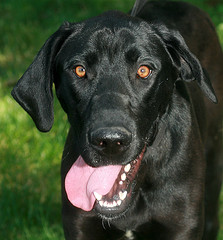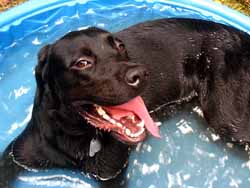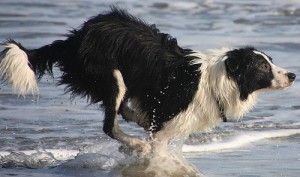Give a Black Dog a Chance
 Have you ever heard of the BBD Syndrome? No, it’s not a recognized disease that is attacking the pet population, but it is killing many, many dogs nonetheless. BBD stands for Big Black Dog. A large black dog in a shelter, particularly Labrador mixes, has very little chances of getting adopted and most of them end up euthanized. And keep in mind this happens with cats as well. These are animals that do not have any personality problems. Some of them, are loving, sweet, well trained, intelligent, with wonderful temperaments. Their only “flaw”? They are black. And no, we are not talking about adorable tiny black Poodles or Chihuahuas, we are talking about gorgeous Labradors and German Shepherds that are put to death simply because of their color.
Have you ever heard of the BBD Syndrome? No, it’s not a recognized disease that is attacking the pet population, but it is killing many, many dogs nonetheless. BBD stands for Big Black Dog. A large black dog in a shelter, particularly Labrador mixes, has very little chances of getting adopted and most of them end up euthanized. And keep in mind this happens with cats as well. These are animals that do not have any personality problems. Some of them, are loving, sweet, well trained, intelligent, with wonderful temperaments. Their only “flaw”? They are black. And no, we are not talking about adorable tiny black Poodles or Chihuahuas, we are talking about gorgeous Labradors and German Shepherds that are put to death simply because of their color.
Some black dogs are taken by rescue groups from shelters before they end up in death row, knowing full well that it make take months, and sometimes even years to find a home for those animals. Some groups don’t even accept black dogs because they are so impossible to place.
The reason is that there are many misconceptions and myths about black dogs, and when people come to the shelter or decide to adopt from a rescue group, they tend to gravitate towards lighter colored dogs, even if it’s unconsciously. Black dogs are regarded as bad dogs, vicious or dangerous. Unfounded superstition, literature and folklore have all conspired to give the black dogs a bad rep. Winston Churchill used to call his depression “the black dog”. The devil was represented by a black Rottweiler in “The Omen”. TV and film tend to portray black dogs as evil. There are legends where ghosts of black dogs haunt the  roads, believed to be restless wicked souls . But these are all just that: myths, legends and superstitions. I would truly think that saving the life of an animal who is destined to get killed would actually bring good luck to the person who did it. Black dogs are just that, dogs that happen to have black fur.
roads, believed to be restless wicked souls . But these are all just that: myths, legends and superstitions. I would truly think that saving the life of an animal who is destined to get killed would actually bring good luck to the person who did it. Black dogs are just that, dogs that happen to have black fur.
Shelters do their best to get their black dogs noticed, dressing them up with bright colored bows, or putting colored blankets in their cages. They often try to get the potential parents to consider a black dog, but when people see so many black dogs still in their cages they can’t help thinking there might be something wrong with them. Adoption fees are sometimes lower for black dogs.
So now that you know, you can all help save many lives if you consider adopting a black dog if you decide to get a life companion. Pass the word, talk to your friends. There might be a wonderful friend with a bright black coat waiting to share its live with them.
Visit this site if you want more information: Black Pearl Dogs
Photos courtesy of:
The Incredible Wolf-Dog Hybrid
A wolfdog, or what I call the incredible wolf-dog hybrid (because I just adore wolves and dogs), is the result of a wolf and dog mix and as a matter of fact, the domestic dog has been re-categorized as a subspecies of wolf.
 Wolfdogs have existed for thousands of years, and it’s known that they were used to hunt for mammoths in Europe. However, the first breeding of a dog with a wolf in Great Britain found on record happened in 1766, and it’s believed that a wolf mated with a Pomeranian, resulting in a litter of 9 puppies… I can only imagine how that happened, unless Poms had not been bred down to toy size yet. Nowadays, wolves are normally bred with Huskies, Malamutes and German Shepherds. The resulting hybrid is the most appealing for those who want an exotic pet and want to keep the wolf appearance. There are many wolf dog breeders around the world, and there are actually many different wolf dog hybrid breeds
Wolfdogs have existed for thousands of years, and it’s known that they were used to hunt for mammoths in Europe. However, the first breeding of a dog with a wolf in Great Britain found on record happened in 1766, and it’s believed that a wolf mated with a Pomeranian, resulting in a litter of 9 puppies… I can only imagine how that happened, unless Poms had not been bred down to toy size yet. Nowadays, wolves are normally bred with Huskies, Malamutes and German Shepherds. The resulting hybrid is the most appealing for those who want an exotic pet and want to keep the wolf appearance. There are many wolf dog breeders around the world, and there are actually many different wolf dog hybrid breeds
Many people are concerned that wolfdogs are not “safe”, but statistics show that there aren’t many instances of attacks by wolfdogs, and the ones you do find always have something to do with the mistreatment of the dogs, like having them chained or locked up in pens, thus not allowing them to be socialized. Under these conditions, it doesn’t matter what breed of dog it is, the result will eventually be an aggressive dog. The personality and disposition of the animal will depend on the way it is treated.
Although wild wolves have a lifespan of 5 to 7 years, a domesticated wolfdog can live from 15 to 20 years! They have a longer lifespan than many big dogs. They are also highly trainable. Wolfdogs are very, very smart animals and they pick up on their training at an amazing speed. They are also good with other dogs, and as with any other animal, small children should always be supervised. I personally had a wolfdog as a nanny for many years. Mishka was an incredible dog who took care of me when I was a toddler, but you have to keep in mind that large dogs will always have a prey instinct and have to be very well socialized and trained to be around small animals and children.
By nature, wolves are very shy animals and they live in packs in close family units. They are loyal, loving and caring. When you have a hybrid, he or she might have traits from either the wolf side or the dog side.  Wolfdogs can show consistently dog-like behavior, but they still retain some wolf-like behaviors like howling, digging, and chewing. A lot of chewing. They tend to be quite destructive if not trained and looked after correctly.
Wolfdogs can show consistently dog-like behavior, but they still retain some wolf-like behaviors like howling, digging, and chewing. A lot of chewing. They tend to be quite destructive if not trained and looked after correctly.
A wolfdog can be an incredibly caring and loving companion, but never lose sight of the fact that hybrids are not just regular dogs, they do have a wild wolf side, which makes them extremely intelligent, they reason and plan things out. People need to be prepared to handle them. Wolfdogs require a lot of attention. You and your family have to become a pack and give the dog all the time and attention to help him or her become a wonderful pet. If you are up for the task, and decide you want a pet wolf hybrid, you can get them from breeders, but it’s also common to find some wolf dogs for adoption
A lot of people end up giving up on their wolfdogs because they are not ready for the task, but thankfully there are places where the hybrids are given sanctuary, where they are appropriately socialized so they can find new homes.
Visit The Wolf Connection
How to Give CPR to a Dog or Cat
Accidents happen, and sometimes it’s our pets that get in trouble. They can drown, choke, get electrical shocks, lose consciousness, stop breathing, etc. If something like this happens, it’s good to know how to give CPR to a dog or cat. Giving CPR to a dog or a cat is very similar to how we do it in humans. If your pet is unconscious, check for breath. Watch their chest or feel for breath or check the gums, which will turn blue from lack of oxygen.
(check the video at the bottom)
1. The first thing you have to do to perform CPR on a dog or cat is lay them on their right side on a flat surface and extend the head and neck to form an airway. Then check for obstructions. They might have swallowed something that got stuck in their throat.
Be aware that dogs have little bones at the base of their tongue that can be confused with a foreign object. Do not try to remove or force anything out unless you can see it.
-If it’s a small dog or a cat, hold him upside down and shake him to try to remove the object. Be careful if you try to use your fingers, because you might push the obstruction further down.
-If it’s a large dog, pull their tongue outward and see if this action dislodges the object. You can try using pliers to remove the obstruction, again, being careful as to not push the object further down.
You can perform the Heimlich Maneuver on the dog or cat and try to dislodge the foreign object.
If there are no obstructions and the air passage is clear:
2. Give them artificial respiration.
With a small dog or cat, you can cover their nose and mouth with your mouth and blow air into them. Give short and shallow breaths every three seconds, just hard enough to make their chest rise until they start breathing on their own.
With a large dog, hold the muzzle to hold the mouth shut. Put your mouth on the nose, covering it completely, and blow gently into their nostrils. The chest should rise. Use longer and deeper breaths every three seconds until they start breathing on their own.
Constantly check their pulse. You can try feeling the heart beats on their chest, or check for a pulse in the inner side of the thigh, near the junction of the leg to the body. The pulse of the femoral artery can be difficult to feel in cats. Use your index and middle fingers, not your thumb.
3. If there’s no pulse, start chest compressions.
On large dogs, lay them on their side and give the compressions placing one hand on top of the other over the widest portion of the rib cage, not the heart. On a smaller dog or cat, place your hand on the rib cage over the heart and the other hand on top. On a puppy or a kitten, put your thumb on the chest and compress, being very careful not to use excessive force.
The rate of compressions depends on the size of your pet:
If they are over 60 lbs, give 60 compressions per minute.
From 11 to 60 lbs, give from 80 to 100 compressions per minute.
Less than 10 lbs, give 120 compressions per minute.
Alternate breaths and compressions. Just like a human, you should give 30 compressions, 2 breaths. Continue the process until you can get the animal to respond or to start breathing on its own.
As soon as the dog or the cat responds, bring him or her to the vet immediately.
Watch the following video to see an example of how to give CPR to a dog or cat
Weimaraners

Long Haired Weimaraner
1.- They have a very smooth short coat that comes in all shades of gray.
2.- There is also a rare long haired variety that has a gorgeous silky coat, with an undocked, feathered tail.
3.- Females can weigh between 55 to 70 lbs, and males can weigh between 70 to 80 pounds.
4.- If you have a Weimaraner, you better have a big back yard and be quite athletic, since these dogs need tons of exercise. If they don’t exercise and play they can become very destructive.
5.- The Weimaraner temperament is cheerful and affectionate, but they do need to be well socialized from puppyhood. They are very protective of their family and very territorial.
 6.- They are good with children, but they need to be controled because they have a tendency to knock kids over with their rambouciousness. They can also be too rough for elderly people.
6.- They are good with children, but they need to be controled because they have a tendency to knock kids over with their rambouciousness. They can also be too rough for elderly people.
7.- The Weimaraner are also known as the “Velcro Dogs”. They get totally attached to their owners and won’t separate from them.
8.- They can suffer from severe separation anxiety, and cannot be left alone too long. This is not a dog to keep in the back yard. They have to be members of the family.
9.- They suffer from gastric problems. They are prone to bloat or suffer from gastric torsion, which is a serious condition that needs to be treated right away.
10.- They need to be trained well to become the wonderful gentle and protective companions that they can be.
Important to know
Did you know that Weimaraners were bred for hunting Lions?
Most Weimaraner owners say their dogs own them and not the other way around.
Yes, You Can Talk to Your Pets
All animal lovers believe that their pets understand most of what they say to them, but it is a proven fact that both dogs and cats are capable of learning human language, not to the extent a child does, of course, but enough to be able to communicate. Your pets will never have the same extensive vocabulary as people, but they are capable of learning dozens if not hundreds of words. Yes, you can talk to pets.
Your pets love to interact with you, and talking to them often gives them the chance to be a part of your world and feel a lot closer to you.
Your pets crave the sound of your voice. They enjoy the attention you are giving them when you talk to them. The natural rhythm of conversation soothes them and pets detect the love and affection in your voice.
 People tend to change their tone and use very simple words when they speak to their pets, just like they do when they speak to children. However, there is no need to restrict your vocabulary since they are very good at understanding what you are saying. Obviously, they don’t understand the words immediately, they need a little coaching to be able to understand what you’re saying. They need to be taught a little.
People tend to change their tone and use very simple words when they speak to their pets, just like they do when they speak to children. However, there is no need to restrict your vocabulary since they are very good at understanding what you are saying. Obviously, they don’t understand the words immediately, they need a little coaching to be able to understand what you’re saying. They need to be taught a little.
At first, talk to them with simple and short words, but you don’t have to use only childish vocabulary. The more extensive vocabulary you use, the more words your pets will learn, and they will also learn to understand your voice inflections a lot better, so there’s no need to talk with an overly infantile voice as we tend to do…. you know: “Who’s momma’s baby? Who’s the baby?” Our tone of voice is important, however. If we use a high pitched, happy voice, it will get them excited. If we lower our pitch and speak calmly, we’ll be able to sooth them, if we use s stern and harsh tone, they will know they did something wrong. Keep in mind that even though pets are capable of understanding words and phrases, they can’t relate them to something that they can’t see. You can’t scold your cat for something he did 10 minutes ago, but he will understand if you scold him at the very moment he’s caught doing the bad deed.
One thing that’s important is that both dogs and cats need to hear the same words and phrases repeatedly to learn them. Just like when you say to your family “Dinner’s ready”, somehow they know what’s coming because they have experienced that whenever you say that phrase, food’s on the table. This means that in order for them to really understand the meaning of a word or phrase, it has to be followed by an action. If you tell your cat “come here”, he won’t know what you’re talking about unless you coach him to come to you in  some way. It’s very important that the first word you use when you talk to your pets is their name, that’s the way to get their attention, but once you get their attention, you need to follow up with some action so that they won’t start tuning out knowing that nothing happens when they turn to see you.
some way. It’s very important that the first word you use when you talk to your pets is their name, that’s the way to get their attention, but once you get their attention, you need to follow up with some action so that they won’t start tuning out knowing that nothing happens when they turn to see you.
You can also use hand signals and body language to communicate with your dog or cat. For instance, when you want him to stop, stand still and give them a palm-out signal. If you want them to come to you, bend down and pat your knees.
Another thing you can do to communicate is learn their language. With dogs it’s a little harder. If you try to bark or growl they’ll just look at you as if you’re crazy, dog language has a very distinctive accent, you might say. But your cats are a different story. If you approach a cat using cat language, look at her sideways and blink your eyes to give a peaceful greeting. If you want her to relax, purr, or if you want to scold her, hiss.
Whatever language you decide to use, whether it’s body language, hand signals, cat language dog language or human language, it’s important that you communicate with your pets. It will definitely deepen your bond and make your life together a lot more interesting.
Congratulations! You have a pregnant cat!
Cat owners are growing more responsible every day and do their best to keep their cats spayed or neutered. However, if for whatever reason you did not spay your female cat and she happened to find an intact male in one of her outings, well… congratulations! You have a pregnant cat! But, what do you know about cat pregnancy? Do you even know how long are cats pregnant?
Even when you think your cat is purely an indoor cat, females in heat have only one thing in their mind, and that’s to find a tom to get them pregnant.
 First thing you should know is that a cat pregnancy or gestation period is about 9 weeks, and that there’s really nothing you can do. Nature, in all her wisdom, will take over and your cat will become a wonderful mother on her own. But you can still prepare yourself and your home for the new family and give the pregnant cat a little help.
First thing you should know is that a cat pregnancy or gestation period is about 9 weeks, and that there’s really nothing you can do. Nature, in all her wisdom, will take over and your cat will become a wonderful mother on her own. But you can still prepare yourself and your home for the new family and give the pregnant cat a little help.
What can you expect if your cat is pregnant?
You will notice that your cat gets a lot more affectionate, she will start eating a lot more,
her nipples will start swelling, her belly will start rowing and a few weeks before the birth, you will start noticing that she’s building a nest. When she starts doing this, you can find a nice quiet, dark area and prepare it for her. Choose an area that the kids and the dog cannot get to, where you can keep a close eye in case you’re needed but where she and her kittens will have peace and quiet. She needs to feel secure. So, you are going to build a nesting box. Get a large cardboard box. It has to be big enough for the pregnant cat to move comfortably and enter and exit with ease. When the birthing begins, there has to be enough space for the kittens to stay close while she delivers them all. The sides of the box have to be tall enough to provide privacy. You can keep one of the flaps on the top as a little roof for the same reason, or put a light blanket on top to keep it covered, but just partially. Cut an opening on the side, large enough for your cat to come in and out, but cut it two or three inches above the floor to prevent the kittens from rolling out or going out to the world too soon. Use an old towel on the bottom and then newspaper. Put a generous amount of sheets on the bottom, and then follow with shredded paper. For the birth itself, put many individual sheets that you can remove after each birth to keep the area clean. Try to bring your cat to it when she starts acting restless and looking like she wants to hide. If she doesn’t like the place you chose for her, check to see where she’s building her nest, and bring her nesting box to that spot. Sometimes they will just prepare their own space, but that might be your bed, or a clothes drawer, so it pays to be vigilant. One thing I would strongly recommend, is to not let her out at all during the last four or weeks. If she gets out, she might nest outside and that would really be a problem.
When the time comes, she will start grooming excessively, specially around her vulva. She will cry and purr a lot and she’ll be pacing and panting a lot. She’ll stop eating and she might even vomit, and discharge a little blood. She will enter her nesting box when she’s ready and the labor will begin. Keep calm and observe. You can always help if there’s a problem.
Just a last word: if you have the idea that a female cat has to first fulfill her destiny as a mother and want her to get pregnant before spaying her, you are wrong. If you want to have a litter of kittens, keep in mind that shelters are full of litters, and most have to be eutanized because not enough people adopt them. So don’t add to the problem. Will you be able to support a large litter? Probably not. So think where all those kittens will end up before you decide not to spay your female cat.
Photo Courtesy of: superna
Keep Your Dog Cool Under Extreme Heat
The Summer months are very unpleasant for all of us, right? We tend to look for air conditioned buildings, or go to the beach and cool off by the ocean, or the pool. Imagine how it would be to be outside, in 90˚ to 110˚ heat with a sweater on, and not being able to sweat to cool off? Not a nice thought…
Imagine just how your dogs feel during extreme heat? Their lives depends on you. You should do your best to keep them cool, since they can’t do it by themselves.
If you must keep your dog outside, please make sure he has a good place with cool shade. The temperature in the shade might be 10 or 15 degrees cooler, but that’s still too hot in a 110 degree day. A wooden or plastic dog house does not provide a cool spot, just the contrary, unless you are able to connect a fan close by to help keep the area cool, or give them a cool bed. If the patio is all concrete, provide them with a mat or grassed area where they can be without burning their paws. Water is tremendously important. If you have a hose, there are special waterers that provide continuous cool and fresh water without any waste. Even in the shade, a bowl of cool water will become a bowl of hot tea in a few minutes.
However, even if you don’t like your dog to be inside the house, please consider closing off the kitchen or some small area of the house for them to spend the day during the Summer. If you go out, don’t turn off the air conditioner, or at least leave them with a good fan and don’t forget the cool water.
These are some things you should keep in mind:
-Avoid taking your dog for walks during the hottest hours. Walk them in the early morning or later in the afternoon.
– Walk them on grass. Asphalt can get too hot and really burn their paws.
Walk them on grass. Asphalt can get too hot and really burn their paws.
-Using booties to avoid their paws from burning, can do more harm than good. They release sweat through their paws, and if they are covered too long, they could suffer heatstroke.
-Bring water with you on the walk for both of you.
-Keep a kiddie pool full of water in a shaded area.
-Short haired, pale dogs are susceptible to sun burn. Apply pet approved sunscreen on the most exposed areas, like the bridge of the nose and the tips of the ears.
-Breeds like Bulldogs, Pugs, Boxers and other snub-nosed dogs can over heat a lot faster due to their shorter airways. Weimaraners are also very susceptible to heat stroke.
-Dogs with dark coats can absorb heat a lot quicker than lighter colored dogs, as well as thick coated dogs.
 -Do not shave your dog for the Summer. Even in the heat, their coats serve an important purpose. Just do your best to keep them cool. Also consider that in some breeds, once you shave off their coat, it will never grow back the same, as is the case with Pomeranians.
-Do not shave your dog for the Summer. Even in the heat, their coats serve an important purpose. Just do your best to keep them cool. Also consider that in some breeds, once you shave off their coat, it will never grow back the same, as is the case with Pomeranians.
And the most important thing you can do for your dog during hot days, is never, NEVER, leave the dog in the car for any amount of time… even in the shade, and even with the windows cracked. The interior of a car can reach 170 degrees in less than 15 minutes in 80 degree weather. It just takes a few minutes for a dog to succumb to heat stroke. They are better off staying home without you in a nice air conditioned place.
Learn the signs of dehydration on dogs: heavy panting, difficult breathing, vomiting or confused behavior. If you catch it early, you can avoid complications. Take them to the vet as soon as you notice this signs. However, you will be better off just helping them avoid the heat altogether.
Border Collies
 1.- It’s frequently referred to as the most intelligent dog breed.
1.- It’s frequently referred to as the most intelligent dog breed.
2.- They are used to assist with the herding of livestock but they are also great companion animals and are been trained to assist the handicapped and as blind guide dogs..
3.-They can be trained like no other, they thrive on praise.
4.-They need tons, and tons of exercise. If they are not challenged daily, they will become very destructive.
5.-They get along with other dogs and children, but you cannot trust them too much with other small pets, although a lot of them live happily with cats.
6.- This is a breed that needs to be very well socialized.
7.-They need constant company. You cannot leave this dog alone at home all day.
8.-They excel at Frisbee-catching and agility competitions,, which is something you should definitely consider enrolling them in if you adopt a Border Collie.
9.- They cannot live in an apartment. They need space to run and move, or they will become very unhappy and problematic dogs.
10.-If they are going to be kept as family pets, you should be willing to some effort into the relationship.
Important to know

To be really happy, they need a lot of leadership, a lot of exercise, and a job to keep them occupied.
They are herders, and will try to children and strangers. They have to be taught not to do so.
They can actually hypnotize cattle. They can control any kind of herd by crouching down and spellbinding the animals by staring at them.
Photos courtesy of:
When There is Blood in a Dog’s Stool
Yeah, it can be quite a scare, but when there is blood in a dog’s stool and it doesn’t always mean a trip to the emergency clinic. But, when should you really worry? Well, it all depends on the general state of the dog.
Do you notice a decrease in energy?
Has she been vomiting?
How much blood was in the stool?
Does he hurt when you push on his belly?
Is her belly swollen?
Has he ingested something like antifreeze, plants or any other substance?
Has she had diarrhea for more than a day?
Does his anal glands look swollen?
If any of the above is happening and the dog is NOT acting normal, then a prompt trip to the vet is totally necessary to make sure it’s not something more serious than having eaten a small bone in the park. But if the dog is active, and eating well and acting as his old self, then you could keep an eye on him for the next few days to see if it happens again. If it doesn’t happen again, you don’t have to rush to the clinic, but make sure to have your vet give him a checkup as soon as possible.
Sometimes dogs will swallow a piece of bone, or a toy or something that scratches the walls of their large intestines, causing him to pass blood in the stool. The blood might appear in the stool for a couple of days, but then it should go away. If it doesn’t, an x-ray might help you see if something is stuck in there. Surgery might be necessary to remove the object.
Parasites can also be the cause of blood in the stool as they irritate the intestine walls. Parasites can be treated with the right medication.
He could have developed an allergy to the food he’s been eating, or there might have been a sudden change of diet.
It could be an infection of the anal sacs. These sacs are located on either side of the anus and they contain a substance with which dogs mark their territory. They get emptied every time your dog poops, however, sometimes they can get infected if they don’t get emptied completely.
Blood can also be cause by an inflammation of the colon or rectum, or a benign or malignant tumor in the abdomen or anal area.
Worst case scenario, it could be Parvovirus or Coronavirus, especially if the dog’s been vomiting as well. These diseases can be very serious, even fatal.
The medical terms for blood in dog stool are hematochezia or melena. In hematochezia, the blood will look fresh and bright red, which means that the blood in the dog’s stool comes most probably from the lower intestines, the colon or the rectum. Hematochezia in dogs can be a sign of a minor problem, but it can also point to a more severe disorder.
In melena, the dog’s stool looks black, which means the blood is digested and comes from the upper intestinal tract. Melena is more serious than a periodic case of hematochezia. If in the past day or so, you gave Peptobismol to the dog, maybe you have nothing to worry about, since Pepto can be the cause of black dog stool.
In any case, blood in the dog’s stool should not be taken lightly and you should always take him or her to the vet as soon as possible. In the meantime, you can feed them white rice with a little garlic or garlic powder mixed in, boiled potatoes, green beans, or a little boiled chicken. Avoid commercial foods until you are sure of what’s going on.
Photo courtesy of:
Should I Choose a Dog or a Cat as a Pet?
You want to adopt a pet, but how do you decide if you want a dog or a cat? Well, the obvious answer lies within you: are you a “dog person”, or a “cat person”? Most people already know this, but if you really never thought about it, let’s see what advantages or disadvantages each species has to help you decide.
Cats and dogs have different needs and characteristics. One thing that applies to both is that they all need attention, you need to budget for their veterinary care, food and emergencies, you need to clean after them, and you have to love them unconditionally.
Now, for the differences.
Dogs:
Your lifestyle will definitely determine if you should have a dog or a cat as a pet. If you like to travel a lot, or work all day, a dog is not for you.
-Different breeds have different characteristics, you should choose one that matches your personality and lifestyle.
-If you travel, boarding a dog is quite expensive.
-A dog needs company and attention. If you have a dog and leave him home alone all day, you will have a very unhappy pet.
-Dogs need exercise. More or less depending on the breed.
-You need to walk them at least a couple of times daily for them to do “their thing”.
-Dogs need to be trained, socialized and housebroken.
-Dogs like to play. They need to be stimulated and love to play with their masters.
-Some dogs shed a lot. You have to be prepared to clean after them constantly.
 -Dogs need to be groomed often. You need to brush their coat, bathe them, and brush their teeth.
-Dogs need to be groomed often. You need to brush their coat, bathe them, and brush their teeth.
-A small dog is a little easier to take care of, but it still needs walks, play and attention. A big dog obviously needs more space.
-A small dog eats very little, but a big dog will eat a lot. You have to be ready for the expense of feeding.
-Dogs love to ride in the car and go hiking, swimming and all kinds of outdoor activities.
-A dog will greet you happily every time you come home, he will want to sleep with you, and in general, share everything with you.
-There are many dog parks where you can take your pet to run and play.
-Dogs are protective of their humans and will be faithful forever.
Cats:
If you work outside your home or travel a lot, and the pet needs to be alone for many ours, a cat might be for you.
-If you travel, boarding a cat is not as expensive, depending on the facility. They could be left at home with a pet sitter visiting once or twice a day.
-All cats have different personalities. Some are affectionate lap cats, and others are more energetic and don’t like to be petted as much. Choose carefully.
-A cat can be left alone to sleep most of the day.
-Cats are independent, but that does not mean you can live them alone all day and not pay any attention to them. They do love company.
 -Cats need to play and be stimulated. They entertain themselves more easily without being destructive.
-Cats need to play and be stimulated. They entertain themselves more easily without being destructive.
-Cats are very easily trained to use their litter box, which requires cleaning at least once a day.
-There’s no need to walk them, though some cats like to walk on a leash.
-Some cats are easily trained to do tricks. Some are very good at fetching.
-Cats eat very little depending on their size, but never as much as a dog.
-Cats don’t need to be bathed, but they do need to get brushed and you need to brush their teeth regularly.
-You can get a cat used to car rides, but they mostly prefer to stay at home.
-Cats can live in small apartments. It’s actually better to always keep them indoors.
-Contrary to popular belief, cats will greet you at the door and follow you around like a dog.
-Cats are playful and a delight to watch as they jump and run and chase.
-You need to have space for a litter box in a well ventilated area, away from kids and out of site.
-Cats like to have scratching posts or kitty condos.
-Cats love to cuddle.
-Cats can be very protective of their humans and will be faithful forever. They do get attached to their owners.
I am one of those strange people that is a cat person and a dog person. I love them both with all my heart and enjoy their different personality traits. I have never had two cats with the same personality, it’s always an adventure to get to know them. And dogs for me, are the best company you can ever ask for. But one thing is certain, both species are incredible, and everybody should have the experience of living with one or both of them at some point.



